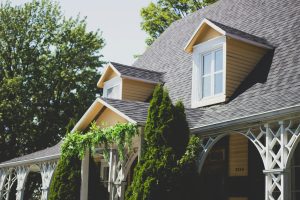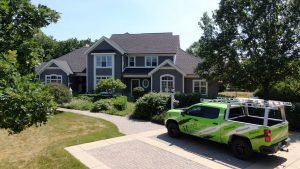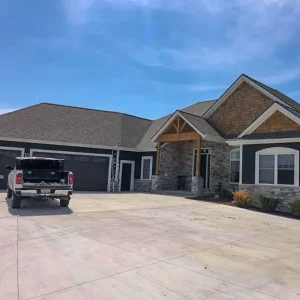If you’re looking around your home and realizing certain rooms feel darker than they should, you’re not alone. We often hear homeowners ask how they can bring in more daylight, especially during our long Wisconsin winters.
The bigger question is which window styles actually make a difference. It’s not just about size, it’s about placement, glass type, and how each room functions throughout the day.
In this article, we’ll walk you through real factors that affect daylight, room by room. You’ll learn which window shapes and placements work best for bedrooms, kitchens, and living areas, and what you need to watch out for when replacing or upgrading your windows. At Heins Contracting, we’ve installed thousands of windows across Southern Wisconsin, and we bring that field-tested knowledge to every job.
A bigger glass isn’t always brighter
You’d think a larger window automatically brings in more light, but that’s not always true. We’ve replaced floor-to-ceiling windows in north-facing rooms that still felt gloomy because of roof overhangs or tree coverage.
Reality check: Orientation and window style impact brightness more than size alone. A double-hung window on a shaded wall will never compete with a casement window on a sunny south-facing side.
Warning: Placing large glass areas without considering privacy or glare can backfire, especially in bathrooms and east-facing living rooms. You’ll end up covering them with blinds half the day.
Room-by-room daylight decisions
Living rooms: Go wide, but don’t forget ventilation
Living rooms are often the largest open areas in a home. Most homeowners want these rooms to feel bright throughout the day, especially during short winter months. For south or west walls, wide picture windows work well, but they don’t open.
Note: Consider flanking picture windows with casements or double-hung windows for airflow without giving up glass area.
Kitchens: Vertical styles for better use of space
Kitchen windows often sit above countertops or sinks. Horizontal sliders or awning windows are practical here, they allow ventilation without taking up too much wall space.
Pro tip: Awning windows open outward from the top, so they shed rain and snow easily, great for year-round air circulation in Wisconsin.
Choosing by style: Fixed vs. functional
Picture windows vs. operable windows
Picture windows are great for maximizing views and light, but don’t open. Casement and double-hung windows offer airflow but often reduce the visible glass area.
Reality check: Replacing a fixed window with an operable style can reduce visible glass by 10–20%, depending on the frame design. That’s a noticeable loss in light if not planned properly.
Warning: If you live near farmland or open fields, avoid sliders that collect dust and allergens in their lower tracks, especially in spring and fall.
Orientation and climate considerations
North vs. south-facing windows
South-facing windows receive more consistent sunlight throughout the day, especially in winter when the sun stays low. In Wisconsin, this helps naturally warm rooms with passive solar heat.
North-facing windows offer indirect light, better for offices or utility rooms where you want brightness without glare.
Note: East-facing windows catch bright light in the morning but fade by afternoon. West-facing windows do the opposite and often cause late-day heat buildup in summer.
Seasonal shifts in daylight
Our region sees up to 6 hours less sunlight in winter. Maximizing winter sun access means selecting window placements and styles that stretch usable light deeper into your home.
Pro tip: In rooms with limited wall space, consider adding transom windows above standard windows or doors to bring in natural light without giving up privacy or wall functionality.
Balancing brightness with privacy and comfort
Bathrooms and bedrooms
These rooms need natural light, but also privacy. Frosted glass, narrow vertical windows, or high-placed awning styles can give you both.
Reality check: We’ve replaced plenty of oversized bathroom windows after homeowners realized they felt too exposed. There’s always a tradeoff between brightness and privacy, frame height and glazing type help manage that.
Energy efficiency and light transmission
Low-E coatings and their impact on light
Most windows now include Low-E coatings to reflect infrared heat and reduce UV damage. But some coatings reduce visible light transmission, called VT, by 10–20%.
Note: A standard double-pane window with Low-E glass typically allows 65–75% VT, depending on coating level. If brightness is a top concern, ask about high-VT options or passive solar glass.
Frame material and thickness
Vinyl frames are common and affordable, but thicker frame profiles slightly reduce glass surface area. Fiberglass and composite frames often allow more visible glass in the same rough opening.
Warning: Don’t assume all “energy-efficient” windows are equally bright, higher insulation doesn’t always mean more daylight.
FAQ
What’s the best window style for natural light?
Picture windows let in the most light but don’t open. Casement windows offer a strong balance between light and airflow. For maximum brightness, combine fixed and operable styles together.
How much does adding larger windows cost?
Widening or increasing window height often requires reframing. Expect to spend $1,200–$2,500 per window, including framing, flashing, and finishing work.
Can I install new windows in winter?
Yes, many styles can be replaced year-round. We use cold-weather-rated sealants and insulate quickly to minimize exposure. Expect install times to take slightly longer in freezing conditions.
Will Low-E windows make rooms darker?
Not necessarily. Standard Low-E coatings reduce visible light by about 10–15%, but most homeowners don’t notice the difference. There are also coatings designed for high light transmission.
Let’s brighten your space with smart choices, not guesswork
Window style matters just as much as size. The wrong choice, even with good materials, can leave rooms dim or uncomfortable all year.
Whether you’re trying to bring light into a shaded kitchen or balance privacy in your bathroom, we’ll help you choose the right fit for every room. Our team at Heins Contracting looks at daylight angles, ventilation needs, and the quirks of older Wisconsin homes to guide every recommendation.
Lighting up your home doesn’t start with guesses, it starts with good planning.




